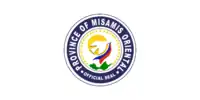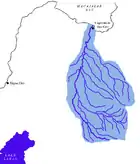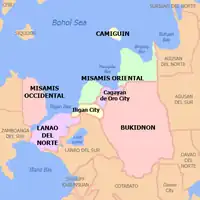Misamis Oriental
Misamis Oriental (Cebuano: Sidlakang Misamis; Tagalog: Silangang Misamis), officially the Province of Misamis Oriental, is a province located in the region of Northern Mindanao in the Philippines. Its capital, largest city and provincial center is the city of Cagayan de Oro, which is governed independently from the province.
Misamis Oriental | |
|---|---|
| Province of Misamis Oriental | |
      (from top: left to right) Mount Balatukan, Balingoan Port, Mount Sumagaya, Libertad coastline, Macajalar Bay and Cagayan de Oro. | |
 Flag  Seal | |
 Location in the Philippines | |
OpenStreetMap | |
| Coordinates: 8°45′N 125°00′E | |
| Country | Philippines |
| Region | Northern Mindanao |
| Founded | 1939 |
| Capital and largest city | Cagayan de Oro |
| Government | |
| • Type | Sangguniang Panlalawigan |
| • Governor | Peter M. Unabia (Lakas) |
| • Vice Governor | Jeremy Jonahmar G. Pelaez (Padayon Pilipino) |
| • Legislature | Misamis Oriental Provincial Board |
| Area | |
| • Total | 3,131.52 km2 (1,209.09 sq mi) |
| • Rank | 43rd out of 81 |
| (excluding Cagayan de Oro) | |
| Highest elevation | 2,560 m (8,400 ft) |
| Population (2020 census)[2] | |
| • Total | 956,900 |
| • Rank | 30th out of 81 |
| • Density | 310/km2 (790/sq mi) |
| • Rank | 30th out of 81 |
| (excluding Cagayan de Oro) | |
| Divisions | |
| • Independent cities | 1
|
| • Component cities | |
| • Municipalities | |
| • Barangays |
|
| • Districts | |
| Time zone | UTC+8 (PST) |
| ZIP code | 9000–9025 |
| IDD : area code | +63 (0)88 |
| ISO 3166 code | PH-MSR |
| Spoken languages | |
| Income classification | 1st class |
| Website | www |
History
Lanao Sultanate era
In the 16th century, the people of the territory were obliged to pay tribute to Maranao Muslim rulers as the regional powerhouses converted to the Muslim faith. Lumads on the coast started converting into Islam or were displaced by other ethnic groups that converted earlier. Those in the interior retained their native faiths.
Spanish colonial era
Misamis Oriental shared a history with Misamis Occidental of being part of the Province of Cebu during the Spanish colonial era. In 1818, Misamis was carved out from Cebu to become a separate province with Cagayan de Misamis (Cagayan de Oro) as its capital and was further subdivided into partidos or divisions: Partido de Cagayan (Division of Cagayan), Partido de Catarman (Division of Catarman), Partido de Dapitan (Division of Dapitan), and Partido de Misamis (Division of Misamis). The new Misamis province was part of the districts of Mindanao during the later part of the 19th Century, with its territory spanning from Dapitan to the west, Gingoog to the East, and as far as Lanao and Cotabato to the south.
Misamis is one of the Spanish-controlled territories vulnerable to Moro raids. The Fuerza de la Concepcion y del Triunfo in Ozamiz was built as a Spanish military installation and one of the staging points in their expeditions against Moros. A fort in Balo-i in present-day Lanao del Norte was also constructed in 1891 on the orders of General Valeriano Weyler in its renewed campaign against the Maranaos. The Fuerza de San Miguel in Iligan was also built, serving as a muster point for Spanish forces in their campaigns in Lanao.
Misamis province

With the organization of the Department of Mindanao and Sulu in 1917, Misamis lost a territory covering Iligan and coastal towns along Iligan and Panguil bays to become part of the Lanao province, making the remaining western and eastern territories of Misamis isolated from each other. Highland areas south of Cagayan de Misamis down to Malaybalay area were carved out to become a sub-province of Bukidnon in 1914, then eventually a full province in 1917. Migrants from Luzon and Visayas then flocked to the area. Most of them are Ilocanos, Tagalogs and Cebuanos.
Legislative Act. No. 3537 approved on November 2, 1929, divided the province of Misamis into two due to the lack of geographic contiguity. It was not until a decade later, on November 28, 1939, that the division between Misamis Oriental and Misamis Occidental was implemented by Act. No. 3777.[3] When Misamis Oriental separated, Don Gregorio Pelaez became its first governor.
Japanese occupation era
In 1942, at the onset of World War II in the Philippines, Japanese soldiers landed in Misamis Oriental to occupy the region. Filipino and American resistance guerrillas operated in the hills and forests of Misamis Oriental and Bukidnon, and both provinces fell under the jurisdiction of the 10th Military District commanded by Col. Wendell Fertig.[4]
The American liberation forces landed in Cagayan in May 1945, with the support of the Filipino and American guerrillas based in Opol, Gingoog, and Tagoloan clearing the beachhead of Japanese defenders for the liberation forces to land.
Philippine independence
Subsequent creations of new local government units in the province occurred after the war. Opol and El Salvador were barangays of Cagayan, but due to their relative isolation from the Cagayan town proper, the residents petitioned for their separation to become municipalities in 1948. El Salvador became a municipality within the said year,[5] while Opol was carved out from Cagayan in 1950,[6] the same year the latter was chartered to become a city.[7] Lagonglong was organized as a separate municipality out of the 11 sitios of Balingasag which were then grouped into 5 barangays.[8] Villanueva was created out of the 5 barrios of Tagoloan in 1962,[9] and the municipality of Libertad out of the 6 barrios of Initao in 1963.[10]
The island of Camiguin was part of the province, and in 1958 it was made into a sub-province. The island eventually separated from Misamis Oriental and achieved regular province status in 1966, with Mambajao as its new provincial capital.
Contemporary
In May 2014 it was reported that an area in Barangay Lapad in Laguindingan, Misamis Oriental, in northern Mindanao, was declared a heritage site. Oyster fossils older than 200,000 years were discovered, according to Balita Pilipinas. Property owner, Raul Ilogon, told Balita Pilipinas that they had been seeing the fossils for 20 years thinking that they were ordinary rocks.[11]
Geography

Located in Northern Mindanao, the province borders Bukidnon to the south, Agusan del Norte to the east and Lanao del Norte to the west. On the north is the Bohol Sea with the island-province of Camiguin just off its northern coast.
Misamis Oriental occupies a total land area of 3,131.52 square kilometres (1,209.09 sq mi)[12]. When the independent city of Cagayan de Oro is included for geographical purposes, the province's land area is 3,544.32 square kilometres (1,368.47 sq mi).[12]
Misamis Oriental, as a coastal province, is dominated by two bays to the north; the Macajalar and the Gingoog Bay.[3] The central portion of the province features several rivers originating from the highlands of Bukidnon, such as the Cagayan.
Administrative divisions
Misamis Oriental comprises 23 municipalities and 2 component cities, which are organized into two legislative districts and further subdivided into 424 barangays. The provincial capital, Cagayan de Oro, is a highly urbanized city that is administered independently from the province.

| |||||||||||||||||||||||||||||||||||||||||||||||||||||||||||||||||||||||||||||||||||||||||||||||||||||||||||||||||||||||||||||||||||||||||||||||||||||||||||||||||||||||||||||||||||||||||||||||||||||||||||||||||||||||||||||||||||||||||||||||||||||||||||||||||||||||||||||||||||||||||||||||||||||||||||||||||||||||||||||||||||||||||||||||||||||||||||||||||||||||||||||||||||||||||||||||
Demographics
|
|
| ||||||||||||||||||||||||||||||||||||||||||||||||||||||
| (excluding Cagayan de Oro) Source: Philippine Statistics Authority[13][14][14] | ||||||||||||||||||||||||||||||||||||||||||||||||||||||||
The population of Misamis Oriental in the 2020 census was 956,900 people,[2] with a density of 310 inhabitants per square kilometre or 800 inhabitants per square mile. When Cagayan de Oro is included for geographical purposes, the province's population is 1,564,459 people, with a density of 441/km2 (1,143/sq mi).
Language
Cebuano is the primary spoken language of the province, with the vast majority claiming it to be their mother tongue. A unique Cebuano dialect spoken in the municipality of Jasaan is called Jasaanon. Many are fluent in Tagalog and English, which are mainly used for business, education, and administration. Maranao is also spoken among the Maranao communities within the province. Other languages that may be heard varyingly in the province include Binukid, Higaonon, Hiligaynon, Ilocano, Kapampangan and Subanon.
Religion
Roman Catholicism predominates in the province with roughly 68% of the population. Other Christian denominations compose most of the minority religions that forms 9% of the Population with 28% belongs Iglesia Filipina Independiente [15] while Islam has a small but steadily increasing number.
Economy
The province is host to industries such as agricultural, forest, steel, metal, chemical, mineral, rubber and food processing. It is home to the 30 square kilometre PHIVIDEC Industrial Estate and the Mindanao International Container Port, all in Tagoloan. Del Monte Philippines, which exports pineapples all over the Asia-Pacific region, has a processing plant in Cagayan de Oro.
On January 10, 2008, Hanjin Heavy Industries and Construction Company of South Korea inked a contract to build a $2 billion shipyard building complex at Villanueva, Misamis Oriental with the PHIVIDEC Industrial Authority. It is bigger than Hanjin's $1 billion shipyard complex in Subic and Olongapo which will hire 20,000 Filipinos to manufacture ship parts. The government declared the 441.8-hectare project site an economic zone (part of 3,000-hectare industrial estate managed by PHIVIDEC).[23]
Government

Misamis Oriental Provincial Government 2022-2025
Executive officials
- Congressmen:
- 1st District of Misamis Oriental with Gingoog: Christian S. Unabia (Lakas–CMD)
- 2nd District of Misamis Oriental with El Salvador: Yevgeny Vicente B. Emano (Nacionalista Party)
- Governor: Peter M. Unabia (Lakas–CMD)
- Vice Governor: Jeremy Jonahmar G. Pelaez (Padayon)
Members of the Sangguniang Panlalawigan
- 1st District:
- 2nd District:
- Syremae N. Emano (Nacionalista Party)
- Gerardo P. Sabal III (Padayon)
- Dexter B. Yasay (Padayon)
- Princess N. Emano (NUP)
- Bliss Francis J. Acain (NUP)
- Sectoral
- Leonard Winstanley - ABC President (Non-partisan)
- Michelle Anayron - PCL President (PDP–Laban)
- Kerwin Jess Soldevilla - SK Federation President (Non-partisan)
- Alan Mandokita - IPMR (Non-partisan)
See also
References
- "List of Provinces". PSGC Interactive. Makati, Philippines: National Statistical Coordination Board. Archived from the original on January 11, 2013. Retrieved June 25, 2014.
- Census of Population (2020). "Region X (Northern Mindanao)". Total Population by Province, City, Municipality and Barangay. Philippine Statistics Authority. Retrieved July 8, 2021.
- Lancion Jr., Conrado M.; cartography by de Guzman, Rey (1995). "The Provinces; Misamis Oriental". Fast Facts about Philippine Provinces (The 2000 Millenium ed.). Makati, Metro Manila, Philippines: Tahanan Books. p. 106. ISBN 971-630-037-9. Retrieved December 28, 2015.
{{cite book}}: CS1 maint: multiple names: authors list (link) - "Guerrillas Liberate Cagayan de Misamis, Oriental Misamis during World War II". metrocdo.com. Retrieved February 1, 2022.
- "REPUBLIC ACT No. 268: An Act Creating the Municipality of El Salvador, Province of Misamis Oriental". lawphil.net. Retrieved September 10, 2021.
- "REPUBLIC ACT NO. 524 - AN ACT CREATING THE MUNICIPALITY OF OPOL, PROVINCE OF MISAMIS ORIENTAL". chanrobles.com. Retrieved September 10, 2021.
- "REPUBLIC ACT NO. 521 - AN ACT CREATING THE CITY OF CAGAYAN DE ORO". chanrobles.com. Retrieved September 10, 2021.
- "Executive Order No. 234, series of 1949: ORGANIZING CERTAIN BARRIOS AND SITIOS OF THE MUNICIPALITY OF BALINGASAG, MISAMIS ORIENTAL, INTO AN INDEPENDENT MUNICIPALITY". officialgazette.gov.ph. July 1949. Retrieved October 6, 2021.
- "REPUBLIC ACT No. 3584: An Act Creating the Municipality of Villanueva in the Municipality of Misamis Oriental". lawphil.net. Retrieved September 10, 2021.
- "REPUBLIC ACT No. 3584: An Act Creating the Municipality of Libertad in the Municipality of Misamis Oriental". lawphil.net. Retrieved September 10, 2021.
- "200,000 year-old fossilized oysters found in Misamis Oriental". Gmanetwork.com. May 16, 2014. Retrieved July 18, 2017.
- "Province: Misamis Oriental". PSGC Interactive. Quezon City, Philippines: Philippine Statistics Authority. Retrieved January 8, 2016.
- Census of Population (2015). "Region X (Northern Mindanao)". Total Population by Province, City, Municipality and Barangay. Philippine Statistics Authority. Retrieved June 20, 2016.
- Census of Population and Housing (2010). "Region X (Northern Mindanao)". Total Population by Province, City, Municipality and Barangay. National Statistics Office. Retrieved June 29, 2016.
- "Data" (PDF). psa.gov.ph.
- "Poverty incidence (PI):". Philippine Statistics Authority. Retrieved December 28, 2020.
- "Estimation of Local Poverty in the Philippines" (PDF). Philippine Statistics Authority. November 29, 2005.
- "2009 Official Poverty Statistics of the Philippines" (PDF). Philippine Statistics Authority. February 8, 2011.
- "Annual Per Capita Poverty Threshold, Poverty Incidence and Magnitude of Poor Population, by Region and Province: 1991, 2006, 2009, 2012 and 2015". Philippine Statistics Authority. August 27, 2016.
- "Annual Per Capita Poverty Threshold, Poverty Incidence and Magnitude of Poor Population, by Region and Province: 1991, 2006, 2009, 2012 and 2015". Philippine Statistics Authority. August 27, 2016.
- "Annual Per Capita Poverty Threshold, Poverty Incidence and Magnitude of Poor Population, by Region and Province: 1991, 2006, 2009, 2012 and 2015". Philippine Statistics Authority. August 27, 2016.
- "Updated Annual Per Capita Poverty Threshold, Poverty Incidence and Magnitude of Poor Population with Measures of Precision, by Region and Province: 2015 and 2018". Philippine Statistics Authority. June 4, 2020.
- "Latest News in the Philippines". Manilastandardtoday.com. January 10, 2008. Retrieved August 18, 2017.
External links
 Media related to Misamis Oriental at Wikimedia Commons
Media related to Misamis Oriental at Wikimedia Commons Geographic data related to Misamis Oriental at OpenStreetMap
Geographic data related to Misamis Oriental at OpenStreetMap- Official website of the Province of Misamis Oriental
- Philippine Standard Geographic Code
- Local Governance Performance Management System
